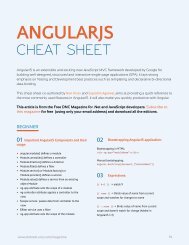build_your_own_angularjs_sample
build_your_own_angularjs_sample
build_your_own_angularjs_sample
Create successful ePaper yourself
Turn your PDF publications into a flip-book with our unique Google optimized e-Paper software.
Build Your Own Angular Chapter 1. Scopes And Digest<br />
}<br />
};<br />
}<br />
console.error(e);<br />
Our digest cycle is now a lot more robust when it comes to exceptions.<br />
Destroying A Watch<br />
When you register a watch, most often you want it to stay active as long as the scope itself<br />
does, so you don’t ever really explicitly remove it. There are cases, however, where you<br />
want to destroy a particular watch while still keeping the scope operational. That means<br />
we need a removal operation for watches.<br />
The way Angular implements this is actually quite clever: The $watch function in Angular<br />
has a return value. It is a function that, when invoked, destroys the watch that was<br />
registered. If a user wants to be able to remove a watch later, they just need to keep hold<br />
of the function returned when they registered the watch, and then call it once the watch is<br />
no longer needed:<br />
test/scope_spec.js<br />
it("allows destroying a $watch with a removal function", function() {<br />
scope.aValue = 'abc';<br />
scope.counter = 0;<br />
var destroyWatch = scope.$watch(<br />
function(scope) { return scope.aValue; },<br />
function(newValue, oldValue, scope) {<br />
scope.counter++;<br />
}<br />
);<br />
scope.$digest();<br />
expect(scope.counter).toBe(1);<br />
scope.aValue = 'def';<br />
scope.$digest();<br />
expect(scope.counter).toBe(2);<br />
scope.aValue = 'ghi';<br />
destroyWatch();<br />
scope.$digest();<br />
expect(scope.counter).toBe(2);<br />
});<br />
42 ©2014 Tero Parviainen Errata / Submit




